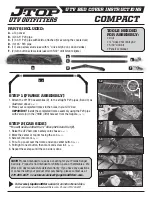
However, the triggering of each individual
system depends on the following factors as
determined in the initial stages of the col-
lision:
R
the type of accident
-
head-on collision
-
side impact
-
rear impact
-
Cabriolet: overturn
R
the severity of the accident, in particular
-
the vehicle's rate of deceleration
-
the vehicle's rate of acceleration
The vehicle deceleration or acceleration and
the direction of force are basically deter-
mined by:
R
the distribution of forces during the colli-
sion
R
the collision angle
R
the deformation characteristics of the vehi-
cle
R
the characteristics of the object with which
the vehicle collides
Factors which can only be seen and measured
after a collision has occurred do not play a
decisive role in the deployment of an airbag
nor do they provide an indication of airbag
deployment.
The vehicle may be deformed significantly,
e.g. the bonnet or the wing, without an airbag
being deployed. This is the case if only parts
which are relatively easily deformed are affec-
ted and the deployment threshold is not
reached. Conversely, airbags may be
deployed even though the vehicle suffers only
minor deformation. This is the case if, for
example, very rigid vehicle parts such as lon-
gitudinal body members are hit and sufficient
deceleration occurs as a result.
Airbags
Important safety notes
Airbag deployment slows down and restricts
the movement of the vehicle occupant.
If the airbags are deployed, you will hear a
bang and a small amount of powder may also
be released. Only in rare cases will the bang
affect your hearing. The powder that is
released generally does not constitute a
health hazard. The
6
SRS warning lamp
lights up.
The SRS/AIRBAG symbol indicates the instal-
lation location of the airbags.
G
Risk of injury
Airbags provide additional protection; they
are not, however, a substitute for seat belts.
Observe the following notes to reduce the risk
of serious or even fatal injury caused by airbag
deployment:
R
All vehicle occupants – in particular, preg-
nant women – must wear their seat belt
correctly at all times and lean back against
the backrest, which should be positioned
as close to the vertical as possible. The
head restraint must support the back of the
head at about eye level.
R
Always secure children less than 1.50 m tall
and under 12 years of age in suitable child
restraint systems.
R
All vehicle occupants must select a seat
position that is as far away from the airbag
as possible. The driver's seat position must
allow the vehicle to be driven safely. The
driver's chest should be as far away from
the centre of the driver's front airbag cover
as possible.
R
Move the front-passenger seat as far back
as possible. This is especially important if
you have secured a child in a child restraint
system on the front-passenger seat.
34
Occupant safety
Safet
y
BA 207 ECE ÄJ 2010/1a; 1; 2, en-GB
mkalafa
Version: 3.0.2.11
2010-01-26T13:03:22+01:00 - Seite 34
Summary of Contents for E-Class 2010
Page 2: ......
Page 3: ......
Page 5: ...BA 207 ECE ÄJ 2010 1a 1 2 en GB mkalafa Version 3 0 2 11 2010 01 26T13 03 22 01 00 Seite 2 ...
Page 332: ......
Page 333: ......
















































